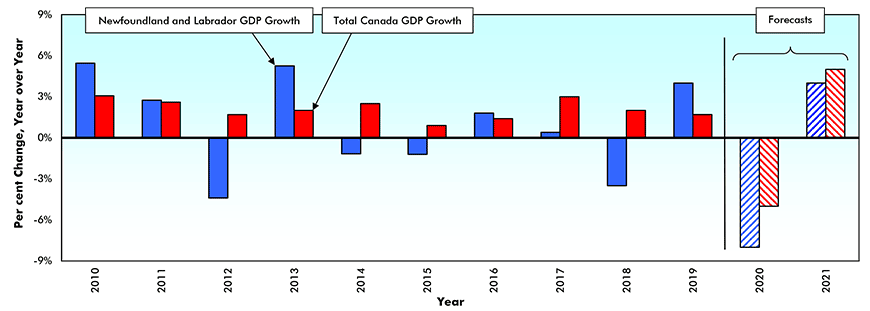Despite having recorded only 340 COVID-19 cases between mid-March and early December, and just 6 active cases per 100,000 population, the second lowest rate among provinces in the country after P.E.I., Newfoundland and Labrador’s economy is in dire straits for two reasons.
First, the steady slide in world oil prices which started at the beginning of this year has caused the value of the province’s major export to drop by -22% year to date, leading to a -26% decline in the total value of the province’s exports.
Second, the combination of the very sharp plunge in oil prices, a significant reduction in crude oil production due to COVID-19 and a concomitant suspension of spending on major capital projects — i.e., including the Muskrat Falls Hydro Project, the White Rose Extension project, the Voisey’s Bay Underground Mine Development, plus several smaller offshore exploration projects — has been responsible for causing capital expenditures in the province to retreat from $7 billion in 2019 to $5.4 billion in 2020.
COVID-19 drop in oil prices has hobbled oil exports and energy investment
The sharp slowdown in energy production and the associated reduction in capital spending, together with measures to prevent the spread of COVID-19, caused employment in Newfoundland and Labrador to fall by -25,000 jobs between February and May. This sharp decline in hiring boosted the province’s unemployment rate from 11.7% in March to a country-leading high of 16.5% in June.
Since mid-year, the hiring outlook in the province has improved. While low energy prices have caused several major energy projects, including White Rose’s Extension work, to remain on hold, higher prices have boosted the year-to-date value of the province’s exports of nickel (+6.5%) and iron ore (+17.0%).
Following a March pause, construction has resumed at Muskrat Falls, although employment at the project will be limited due to COVID-19 social distancing. Employment at the Voisey’s Bay Mine has also picked up, after being suspended in March.
Since June, the jobs count in the province has crawled back from 204,000 to 224,000, just a shade above its pre-COVID level of 223,000, and the province’s unemployment rate has settled back down to 12.2%, the same as in February before the pandemic.
Stronger housing demand points to pickup in residential construction
In response to the above-noted strong pattern of job ‘re-creation’, the lowest mortgage interest rates since late 2015, a significant increase in pent-up post-COVID housing demand, and a gradual increase in admissions of permanent residents, sales of existing homes in the past five months (June through October) are up by +22% year to date. Reflecting this improvement in demand, the months’ supply of homes for sale now stands at 8.9, well below the recent high of 17.4 reached in May.
Although the number of dwelling units started in the province in the past five months is down by -22% year to date, the strong gain in applications to build new residential dwellings and the fact that the inventory of completed and unoccupied units is at an eight-year low, strongly suggest residential construction will pick up steam during the first half of 2021.
Several key indicators are signaling that the pace of economic activity in Newfoundland and Labrador is quickening heading into 2021. However, the on November 22 indicates the way forward, as for all provinces across the country, will not be smooth.
It should be noted that there are other clouds on Newfoundland and Labrador’s economic horizon. They include potential electricity price hikes stemming from the higher-than-projected construction cost of Muskrat Falls and higher taxes necessitated by a due to a combination of reduced offshore oil royalties and higher COVID-related spending.
The bottom line
Looking further ahead, the prospect that recently developed effective vaccines will trigger a post-COVID surge in global economic activity should give a significant boost in demand for oil, the province’s major export product. Also, the lifting of restrictions on travel into the province will breathe new life into the tourism industry which has been flattened by the virus since March.
After posting GDP growth of 4% in 2019, we estimate that the harmful effects of COVID-19 in the first half of this year will cause Newfoundland and Labrador’s economy to contract by -8% in 2020. Next year, the provincial GDP advance should be in a range of +3% to +5%, driven by a rebound in domestic and external demand.
John Clinkard has over 35 years’ experience as an economist in international, national and regional research and analysis with leading financial institutions and media outlets in Canada.
Real* Gross Domestic Product (GDP) Growth – Newfoundland and Labrador vs Canada

Chart: ����ӰԺ – CanaData.



Recent Comments
comments for this post are closed